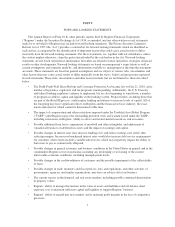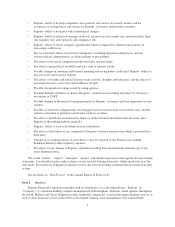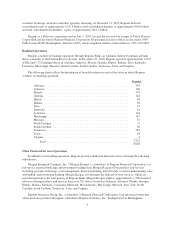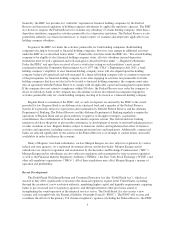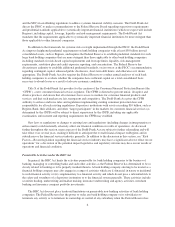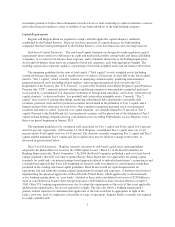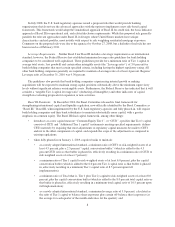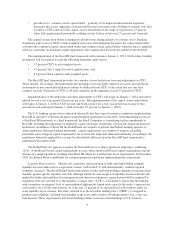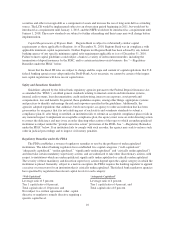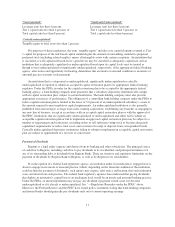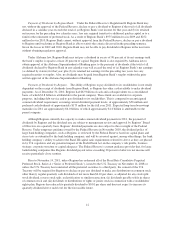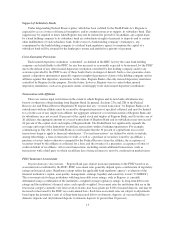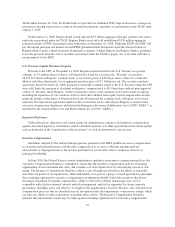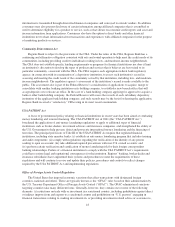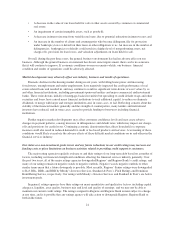Regions Bank 2010 Annual Report Download - page 25
Download and view the complete annual report
Please find page 25 of the 2010 Regions Bank annual report below. You can navigate through the pages in the report by either clicking on the pages listed below, or by using the keyword search tool below to find specific information within the annual report.
“Undercapitalized” “Significantly Undercapitalized”
Leverage ratio less than 4 percent,
Tier 1 capital ratio less than 4 percent, or
Total capital ratio less than 8 percent.
Leverage ratio less than 3 percent,
Tier 1 capital ratio less than 3 percent, or
Total capital ratio less than 6 percent.
“Critically undercapitalized”
Tangible equity to total assets less than 2 percent.
For purposes of these regulations, the term “tangible equity” includes core capital elements counted as Tier
1 capital for purposes of the risk-based capital standards plus the amount of outstanding cumulative perpetual
preferred stock (including related surplus), minus all intangible assets with certain exceptions. An institution that
is classified as well-capitalized based on its capital levels may be classified as adequately capitalized, and an
institution that is adequately capitalized or undercapitalized based upon its capital levels may be treated as
though it were undercapitalized or significantly undercapitalized, respectively, if the appropriate federal banking
agency, after notice and opportunity for hearing, determines that an unsafe or unsound condition or an unsafe or
unsound practice warrants such treatment.
An institution that is categorized as undercapitalized, significantly undercapitalized or critically
undercapitalized is required to submit an acceptable capital restoration plan to its appropriate federal banking
regulator. Under the FDIA, in order for the capital restoration plan to be accepted by the appropriate federal
banking agency, a bank holding company must guarantee that a subsidiary depository institution will comply
with its capital restoration plan, subject to certain limitations. The bank holding company must also provide
appropriate assurances of performance. The obligation of a controlling bank holding company under the FDIA to
fund a capital restoration plan is limited to the lesser of 5.0 percent of an undercapitalized subsidiary’s assets or
the amount required to meet regulatory capital requirements. An undercapitalized institution is also generally
prohibited from increasing its average total assets, making acquisitions, establishing any branches or engaging in
any new line of business, except in accordance with an accepted capital restoration plan or with the approval of
the FDIC. Institutions that are significantly undercapitalized or undercapitalized and either fail to submit an
acceptable capital restoration plan or fail to implement an approved capital restoration plan may be subject to a
number of requirements and restrictions, including orders to sell sufficient voting stock to become adequately
capitalized, requirements to reduce total assets and cessation of receipt of deposits from correspondent banks.
Critically undercapitalized depository institutions failing to submit or implement an acceptable capital restoration
plan are subject to appointment of a receiver or conservator.
Payment of Dividends
Regions is a legal entity separate and distinct from its banking and other subsidiaries. The principal source
of cash flow to Regions, including cash flow to pay dividends to its stockholders and principal and interest on
any of its outstanding debt, is dividends from Regions Bank. There are statutory and regulatory limitations on the
payment of dividends by Regions Bank to Regions, as well as by Regions to its stockholders.
If, in the opinion of a federal bank regulatory agency, an institution under its jurisdiction is engaged in or is
about to engage in an unsafe or unsound practice (which, depending on the financial condition of the institution,
could include the payment of dividends), such agency may require, after notice and hearing, that such institution
cease and desist from such practice. The federal bank regulatory agencies have indicated that paying dividends
that deplete an institution’s capital base to an inadequate level would be an unsafe and unsound banking practice.
Under the FDIA, an insured institution may not pay any dividend if payment would cause it to become
undercapitalized or if it already is undercapitalized. See “—Regulatory Remedies under the FDIA” above.
Moreover, the Federal Reserve and the FDIC have issued policy statements stating that bank holding companies
and insured banks should generally pay dividends only out of current operating earnings.
11


